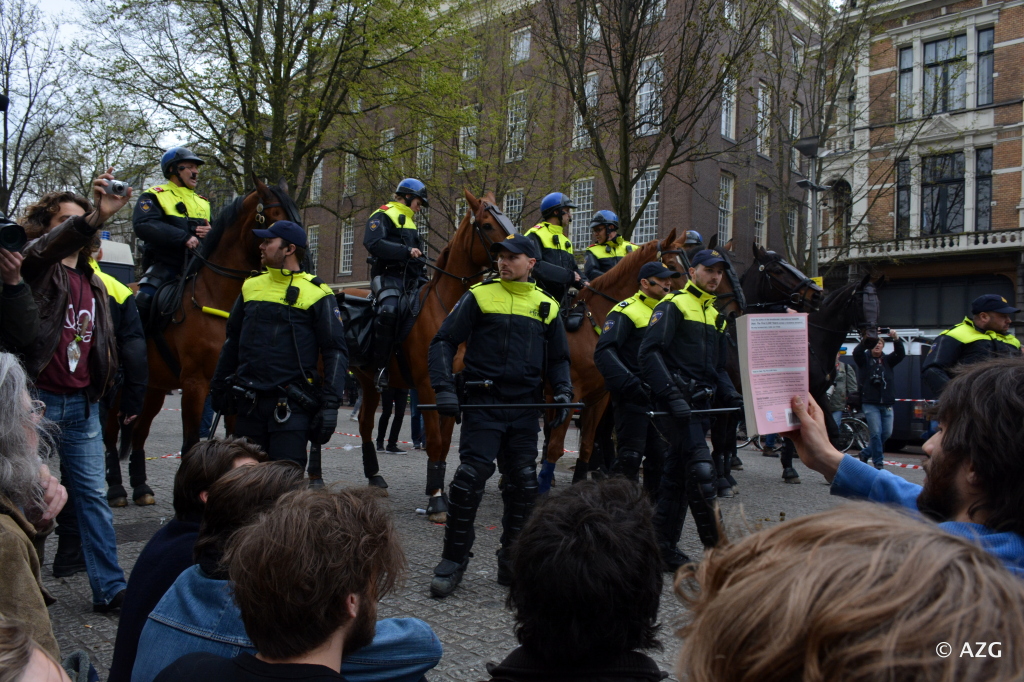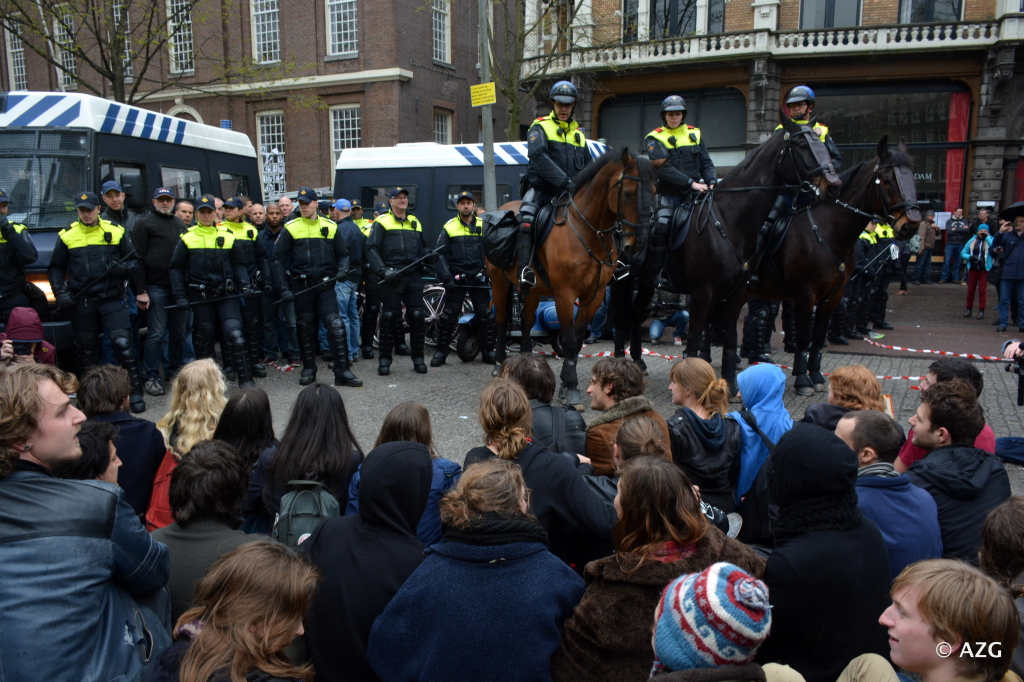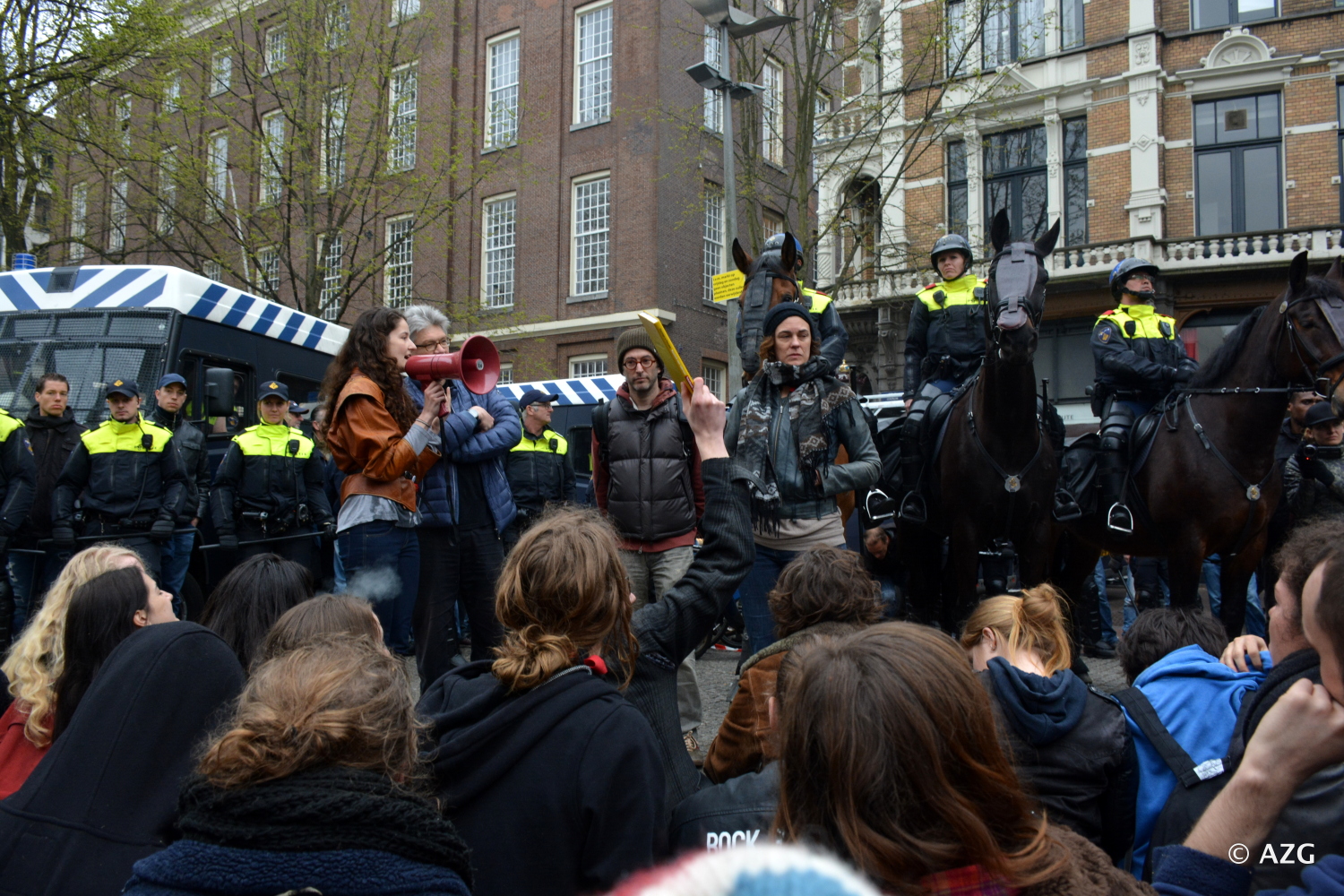By Anna Ziya Geerling
Pictures are by Anna Ziya Geerling ©
In the weekend of 11 and 12 April, the New University movement (in Dutch ‘De Nieuwe Universiteit’/DNU) of Amsterdam had planned a ‘Festival of Science and Humanities.’ Many lectures by interesting speakers such as Ewald Engelen as well as workshops and discussion sessions made up the programme.
It was on this note that the 44-days lasting occupation of the Maagdenhuis was to peacefully come to an ending. The building had been occupied with the aim of making the university more democratic. The Festival would be the climax of sharing and generating knowledge, as had been the main activity in the occupied/liberated Maagdenhuis so far.
However, the UvA Board of directors (in Dutch ‘het College van Bestuur’ /CvB) decided otherwise. Instead of having the festival that had been organised in cooperation with the CvB, and leaving voluntarily on Monday or even Sunday evening after cleaning up, the students were evicted by an excessive amount of riot police and unnecessary violence the day the Festival started. This after the CvB won a court case against four (ex)occupiers of the building while their argumentation was lacking in all possible ways.
The CvB, referring to themselves as ‘the UvA’, argued that the Festival planned by the students and professors (apparently not ‘the UvA’) would not be safe because of fire safety and the word ‘Festival’, which implied “music and stuff”. In previous negotiations between the students and the board, the CvB had explicitly stated that the security would be fine and the students had organised a safety team that would cooperate with the CvB’s own security team. Stressing the word Festival totally disregarded the extensive program of lectures and the fact that it was actually the CvB who had proposed this word, “Festival (of Science)”, as they thought it “sounded fun.” The lawyers used sources such as Facebook and Pownews in their argumentation, among others to prove that the festival would include “doing lots of drugs”. Lastly, they kept on repeating that they were ‘dealing with a heterogeneous group’, and therefore did not know whom they were negotiating with anymore. This because the democratic General Assembly of DNU had made the entirely legitimate decision to reject the deal the CvB had proposed. Well, for your information, dear board of directors, humanity is a heterogeneous group, and this is how democracy works.

Overall, it was thus quite obvious that all the CvB was really trying to do was to have the last word. “Deal or no deal,” as the lawyers of the CvB themselves concluded their plea. Hooray for once again reaffirming you are using your power well, dear CvB! This correct use of power was once again exemplified by the incredible amount of riot police (‘Mobiele Eenheid’ / ME) surrounding the Maagdenhuis that Saturday morning: tens of buses, 20-something horses, and long lines of riot police with their batons (heavy police sticks) ready. While a few professors and students attempted to move the festival outside by lecturing from the staircase, all students left the building voluntarily within the first minutes. The only exception was one student, who tied himself to furniture in the University of Colour office (a sub-group of DNU focused on uncovering racism and neo-colonialism in higher education) out of protest.
However, the eviction did not end at making sure everybody left the building. Instead, the riot police occupied almost the entire public square in front of the building, making the relocation of the festival to the outside impossible. The students and professors that found themselves trapped in this circle first tried to continue their lectures, until they were pushed off the stairs and then moved away from the Maagdenhuis onto the square. Riot police responded by beating the students to the ground, while they were already in the process of sitting as a form of non-violent protest.
At some point the ‘silent police,’ riot police dressed up as civilians, started to forcefully drag students away in unexpected moments to arrest them. This led to much chaos, and many batons finding their way to peaceful students. I myself was faced with such a wrestling group of students and riot police approaching from behind the line of riot police that stood in front of me as I was trying to film the violence. When turning to walk away, I found riot police having beaten students to the ground behind me. Thus trying to leave the scene on the left side, I had to walk past this line of riot police, and, while obviously simply trying to walk away and not even being able to see the person who did it, I suddenly felt said batons smashing in onto my back and shoulder, which continued to be swollen and hurtful, blue and yellow, up to 1,5 weeks later.
To me, this shows very eloquently the working strategies of this riot police: not aimed at keeping the order or acting in a ‘de-escalating fashion’, as they were instructed by the mayor to do, but rather taking the CvB’s approach, who requested this exaggerated amount of riot police, and simply using any kind of opportunity to arrest and beat up innocents. Professors were dragged away with their arms held in unnatural positions, and horses were used to run into peacefully standing and sitting groups, basically squashing students.

At some point, the professors returned, and all the students, including me, sat down on the square to continue the lectures. The backdrop of riot police feeling all tough and useless was quite amusing. Yet, silent police kept on posing a threat. After a while, they probably realised that this was not the best press attention to receive, and the riot police buses started to leave. However, after the press had left, and as soon as the students thus decided to move to the open (and welcoming) cafeteria of a UvA building to continue the planned lectures of the festival, the riot police suddenly showed up again with five buses at each end of the street at this public building. Why is still a question, but intimidation seems the only plausible explanation.
Because of this, we were basically forced to leave the building and were consequently hunted through the streets of Amsterdam by buses surrounding us and waiting for us at every corner. There was a great feeling of panic over the group, especially as getting behind could mean being ‘picked up’ from the street by the silent police. Arriving at the Maagdenhuis again, those ten buses that had left earlier came back now that the press was gone, and so we finally settled down in bar Schuim at the Spuistraat to wait until they had left.
As has been in the news for the last weeks,the police were able to arrest 10 people. As these people did not disclose their identities to the police, they were threatened with placement in foreign detention centres, a threat that was shortly thereafter implemented. The fact that these detention centres were used as powerful tools of intimidation once again indicates the horrendous conditions that exist in such detention centres.
All this happened just because students want a democratic, decentralised educational system. Because they want to be able to decide what they learn. Because they do not accept the financialisation of the institute that should be focused on facilitating the distribution of knowledge, rather than the generation of profit. And finally, because they feel that they are not raw material that can be pushed through the factory press of repetition that the university has come to be, but rather a diversity of critical beings devoted to learning and producing knowledge.
The Maagdenhuis will be missed. It was not simply a form of leverage in the process of the protest, it was a meeting place for thousands of visitors, intellectuals, artists, high-ranking professors and many critical students. It was a place of generating knowledge, fierce debates, making connections, and deep democratic assemblies. It was a warm, welcoming and open community, in which everybody shared and created. However, it was just a facilitator of a movement. A movement that does not live in a building, but in the hearts and minds of many. A movement that has not only spread to many other cities around the Netherlands, but has crossed borders, to the UK, South Africa, Australia and Canada amongst many others.
Dear CvB, you must have realised by now: you can evict the building, but you cannot and will never evict the movement.
Anna Ziya Geerling, Class of 2016, is an Anthropology, Law and Politics major.

